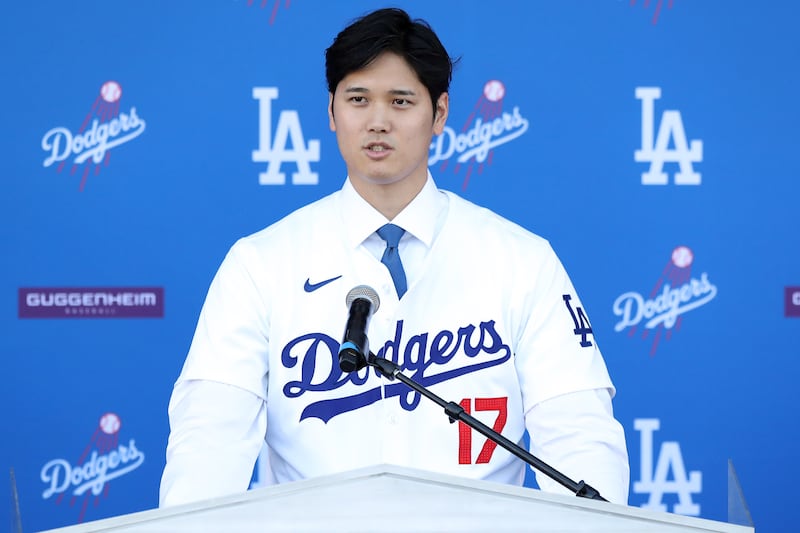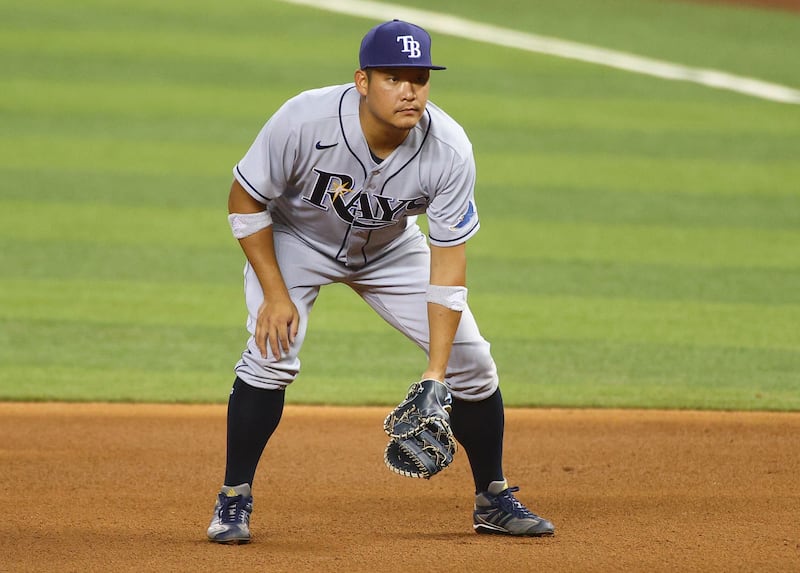Earlier this month, the Los Angeles Dodgers signed Shohei Ohtani to a 10-year, $700 million (€635 million) deal, the largest contract in professional sports history. The eye-watering sums involved are a true measure of his standing. The best player of his generation. Already deep in the conversation for greatest of all time. Uniquely in the modern game, he is as good at dispatching the baseball out of the park as he is at shutting down opponents with his pitching. A rare twin threat in a way most famously espoused a century ago by Babe Ruth, whose preternatural feats established parameters thought beyond all who came after him. Until now.
“He has strained the limits of language,” wrote Tim Keown of what Ohtani has done since arriving in the major leagues in 2018. “Historic and unprecedented, just to get those two out of the way early. But how many ways can disbelief be expressed? How many superlatives strung together does it take to equal utter meaninglessness? Discerning the meaning of something demands some sort of comparison, or at least a relevant reference point. Ohtani, having driven past – and then back over – the Babe Ruth comparisons, has left us to our own devices.”
[ Shohei Ohtani agrees to record $700 million contract with LA DodgersOpens in new window ]
If Ruth was Falstaffian off the field, braggadocious and epic on it, the quintessential American hero, Ohtani is the opposite in terms of style, character and biography. Born and reared in Japan, his taciturn persona reflects the values of the very different baseball culture that shaped him, a rigorous environment where martial discipline is a feature of training. Young players are taught humility by, among other things, being forced to set up the fields before putting in insane day-long shifts honing fundamentals, then cleaning up the facility afterwards. This is the most modest of superstars because he couldn’t have turned out any other way.
The impact of his success in his native land can be gauged by the fact that Anaheim Stadium, home of his previous employers the Los Angeles Angels, used to be littered with advertising for Japanese probiotic drinks, video games, electronic devices, sports drinks and, bizarrely, cat treats. His every move across America on and off the diamond is tracked by a posse of compatriot journalists permanently stationed in California by media outlets in Tokyo who recognise there is an insatiable appetite for news about him.
Dave Hannigan: Bill Belichick’s latest chapter in American football reads like tragicomedy
Kevin Kilbane: Ireland are going down a dangerous road with Heimir Hallgrímsson
How can Ireland qualify for the World Cup? Here are the permutations
Gordon D’Arcy: Since losing my dad, I’ve thought a lot about what it means to be a father
There is immense national pride that the game’s biggest star, who recently donated 60,000 baseball mitts to kids back home, is one of their own. Yet, the sport is in some trouble in Japan. Many of the current generation have started to question the production line that sent forth Ohtani and a succession of other major league stars since Hideo Nomo made his breakthrough with the Dodgers back in 1995. The number of high-school kids playing the game is down by 40 per cent over the past decade, a startling statistic until the reasons for the waning interest are explained.

More and more boys shy away from a sport that involves ludicrous levels of commitment and being regularly humiliated by martinet coaches. These drill sergeants demand teenagers perform hundreds of repetitions of throwing and hitting routines each day, devoting every spare moment of their lives to quasi-militaristic training. Some parents are of a similar stripe. The father of Ichiro Suzuki, the most successful Japanese export to America before Ohtani, boasted about his role in developing the kid and how he allowed him six hours per year to play with friends. Per year.
“I’ve seen small children who want to play baseball quitting because of the excessive training or because they play when they are injured,” said Yoshitomo Tsutsugo, another Japanese player to make it to the Major Leagues. “If we don’t tackle the root causes of these problems, they are just going to keep happening over and over. The way I see it, the problem is that even at a young age, the focus is on winning rather than education for kids’ futures. We need to end those knockout tournaments and put limits on pitches and on practice.”

Tsutsugo only realised his homeland had so many issues that needed to be addressed when he spent time in the Dominican Republic. There, in a country that also produces future major leaguers, he saw teenagers playing a more joyous, less intense brand of ball, a version of the sport where they looked like they were having fun. A world removed from Koshien, Japan’s annual high-school baseball tournament that combines the hoopla of a Super Bowl with the national hysteria of a March Madness, when the entire nation watches kids (crucial word) on live television try to forge reputations and win glory. Often, at great personal physical cost.
At Koshien, the most gifted might throw 500 pitches over the course of a week, way more than that if their side goes deep in the competition. A ridiculous strain to put on young arms and the cause of many overuse injuries. Even in America, not exactly known for common sense in children’s sport, 16-year-olds must have mandatory rest days after throwing 95 pitches in a single game. His Japanese counterpart might hurl double that number in a single outing then step up to the mound again next morning. A toughness perversely regarded as a source of national pride, a resilience that makes their players unique, the kind that produces a $700 million phenom like Ohtani.
















